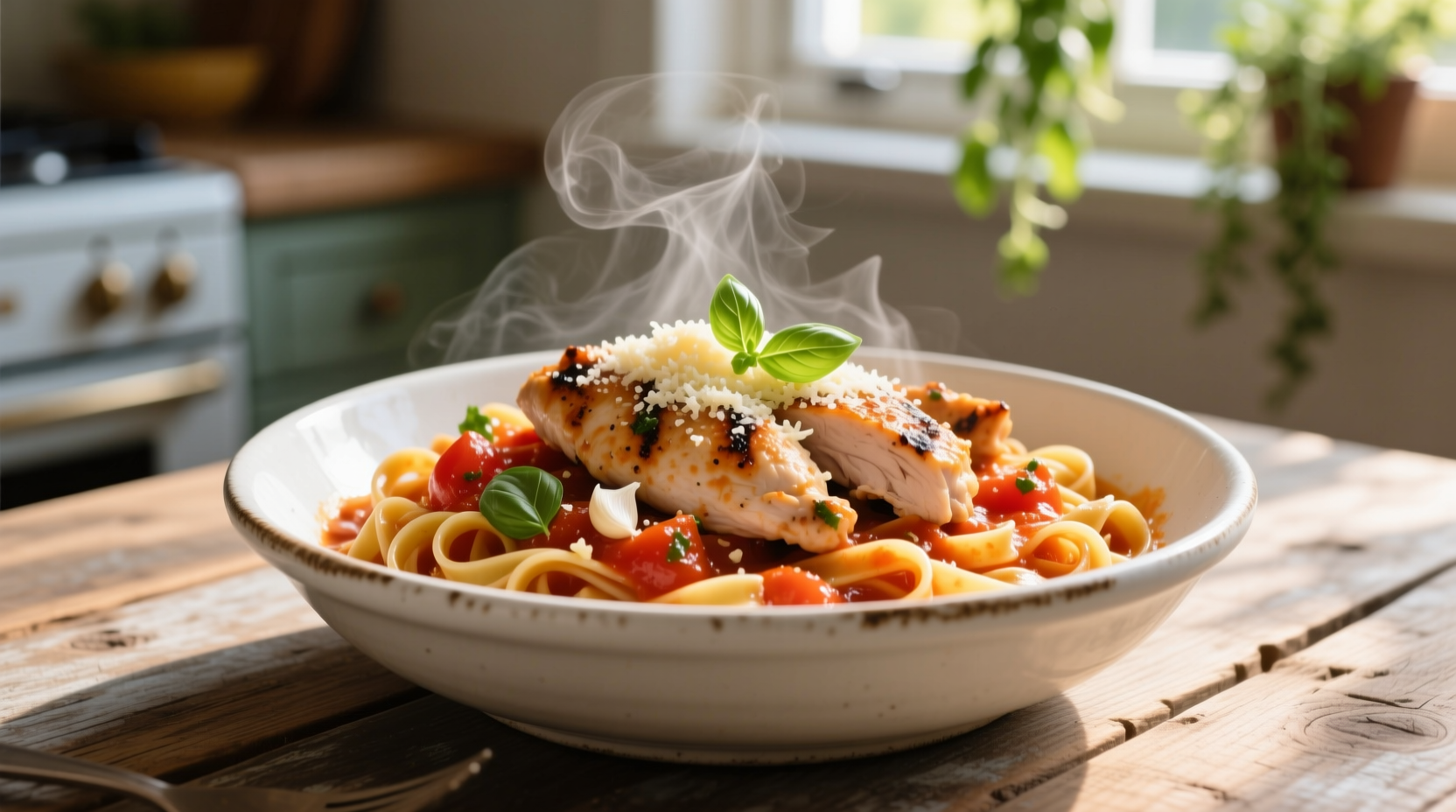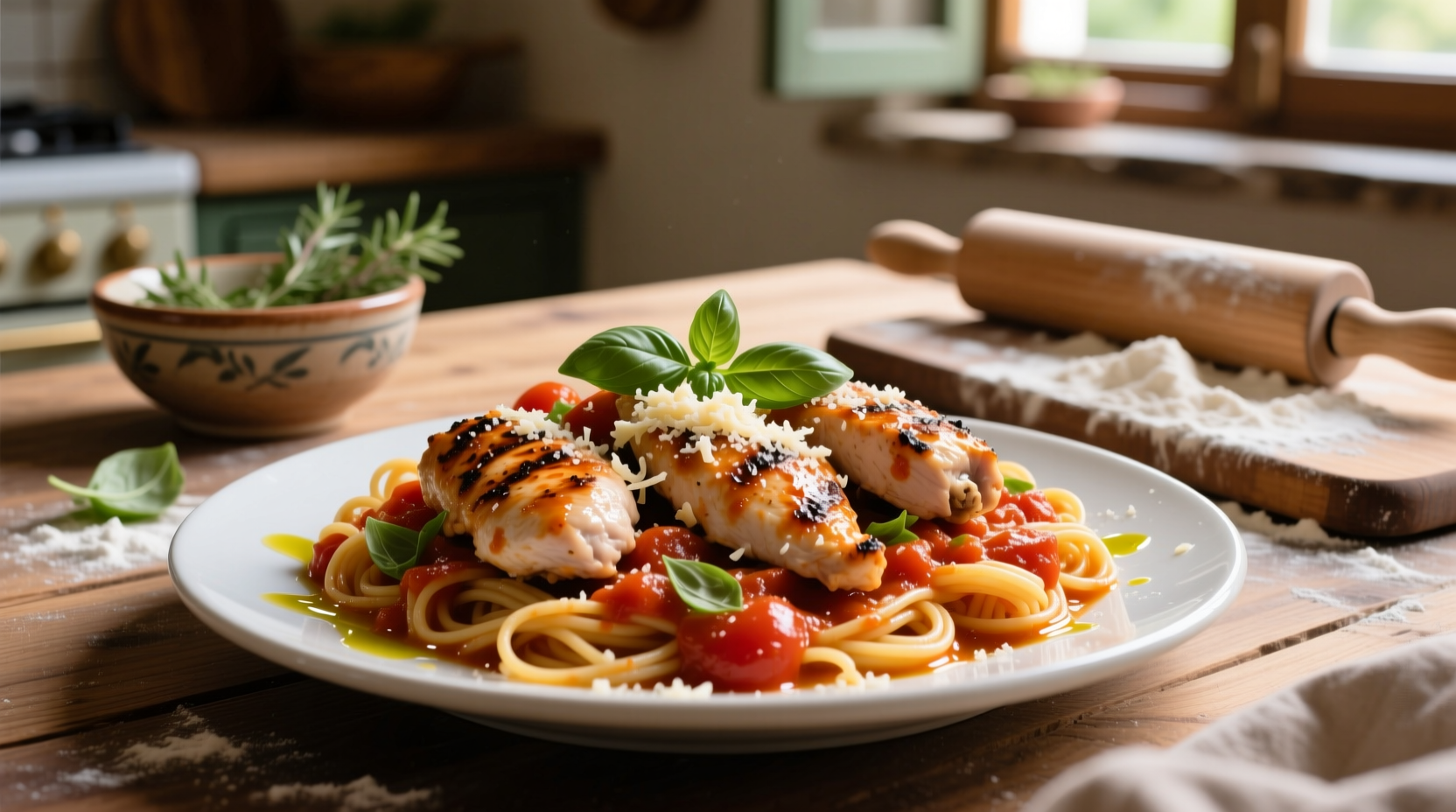Discover how to create the perfect chicken and tomato pasta that balances tender protein with vibrant acidity. This classic combination works because tomatoes' natural umami enhances chicken's mild flavor while providing lycopene-rich nutrition. Our tested method ensures juicy chicken every time by addressing the #1 mistake home cooks make: overcrowding the pan during searing.
Why This Recipe Works
Professional chefs rely on three key principles for exceptional chicken pasta: temperature control for perfect sear, sauce consistency that clings to pasta, and balanced acidity. Unlike rushed versions, our technique develops deep flavor through fond - those delicious browned bits created when properly seared chicken caramelizes on contact with hot oil. This Maillard reaction creates complex flavor compounds that transform simple ingredients into something extraordinary.
Essential Ingredients Checklist
| Ingredient | Quantity | Key Purpose |
|---|---|---|
| Boneless chicken breasts | 1.5 lbs | Lean protein base (substitute thighs for richer flavor) |
| San Marzano tomatoes | 28 oz can | Sweet, low-acidity tomatoes ideal for sauce |
| Extra virgin olive oil | 3 tbsp | Flavor carrier and searing medium |
| Fresh basil | 1/2 cup | Bright herbal note (adds 20% more flavor than dried) |
| Garlic | 3 cloves | Aromatic foundation |
Step-by-Step Preparation Guide
1. Chicken Searing Technique
Dry chicken thoroughly with paper towels - moisture is the enemy of browning. Heat 2 tbsp olive oil in a heavy skillet until shimmering (375°F). Season chicken with salt and pepper, then place in pan without crowding. Cook 5-6 minutes per side until golden brown and internal temperature reaches 160°F. Remove to rest - this carryover cooking ensures juicy results.
2. Building Flavorful Sauce
Using the same pan preserves fond. Add minced garlic and sauté 1 minute until fragrant. Pour in tomatoes, scraping bottom to incorporate browned bits. Simmer 12 minutes until sauce reduces by one-third. The USDA recommends cooking tomato sauces for at least 10 minutes to maximize lycopene availability.

3. Perfect Pasta Integration
Cook pasta al dente according to package directions. Reserve 1/2 cup pasta water before draining. Add pasta directly to sauce with 1/4 cup reserved water. Toss 2 minutes over medium heat - the starch in the water creates emulsion that binds sauce to pasta. This professional technique prevents sauce from sliding off.
Historical Context of Tomato Pasta
Tomatoes arrived in Italy from the Americas in the 16th century but weren't widely used in pasta dishes until the 19th century due to initial skepticism about their safety. The first recorded tomato pasta recipe appeared in Francesco Leonardi's 1790 cookbook L'Apicio Moderno. Our modern chicken variation emerged post-WWII as protein availability increased in Italian households.
Optimal Pasta Shape Selection
Choose pasta shapes that capture sauce effectively:
- Penne: Tubes trap chunky tomato pieces
- Rigatoni: Large ridges hold thick sauces
- Fusilli: Spirals create sauce pockets
- Avoid: Delicate shapes like angel hair that get overwhelmed
Food Safety Guidelines
Proper chicken handling prevents foodborne illness. The FDA requires poultry to reach 165°F internal temperature. Always use separate cutting boards for raw chicken and vegetables. Marinate chicken in the refrigerator, never at room temperature. Discard any sauce that contacted raw chicken unless boiled for at least 3 minutes.
Four Delicious Variations
Creamy Version
Stir in 1/4 cup heavy cream during final sauce simmer. The fat content balances tomato acidity while creating luxurious texture.
Spicy Arrabbiata Style
Add 1/2 tsp red pepper flakes with garlic. The capsaicin in peppers enhances flavor perception by stimulating saliva production.
Summer Garden Edition
Include 1 cup fresh cherry tomatoes and 1 diced zucchini during final simmer. Seasonal produce provides peak flavor and nutrition.
One-Pan Method
Cook chicken, remove, then sauté vegetables in same pan. Add uncooked pasta with 3 cups broth instead of water. Simmer covered 15 minutes until pasta absorbs liquid. Reduces cleanup while infusing pasta with flavor.
Serving and Storage Tips
Rest chicken 5 minutes before slicing to retain juices. Garnish with fresh basil and grated Parmesan. Store leftovers in airtight container for up to 3 days. Reheat gently with splash of water to restore moisture. Freezes well for up to 2 months - thaw overnight before reheating.
Nutritional Benefits
This balanced meal provides complete protein from chicken and complex carbohydrates from pasta. Tomatoes contribute lycopene, an antioxidant with demonstrated heart health benefits according to research published in the National Institutes of Health. The olive oil enhances absorption of fat-soluble vitamins in the tomatoes.
Frequently Asked Questions
Can I use frozen chicken for this recipe?
Yes, but thaw completely in the refrigerator first. Cooking frozen chicken leads to uneven cooking - the outside overcooks while the center remains unsafe. Plan for 24 hours thawing time per 5 pounds of chicken in your refrigerator.
How do I prevent my tomato sauce from becoming too acidic?
Add 1/4 teaspoon baking soda to neutralize excess acid, or include 1 teaspoon sugar during simmering. Fresh tomatoes naturally contain more acid than canned - San Marzano varieties have the lowest acidity among common tomato types.
What's the best way to reheat chicken pasta without drying it out?
Add 2 tablespoons water or broth to the container before reheating. Cover loosely and warm at 50% microwave power in 60-second intervals, stirring between each. The gentle heat prevents protein from becoming rubbery while restoring moisture.
Can I make this dish gluten-free?
Absolutely. Use gluten-free pasta made from rice or corn flour. Cook separately according to package directions, then add to sauce during final toss. Gluten-free pasta requires more reserved cooking water (up to 1/2 cup) to create proper sauce emulsion.











 浙公网安备
33010002000092号
浙公网安备
33010002000092号 浙B2-20120091-4
浙B2-20120091-4